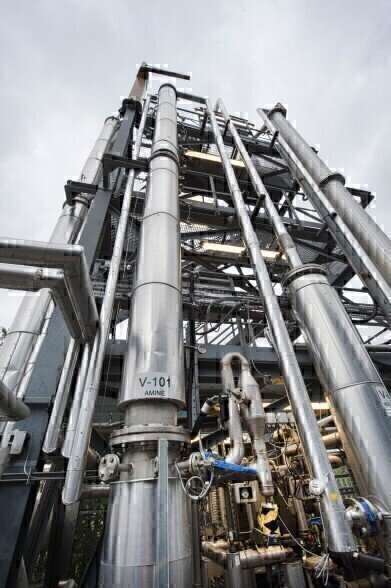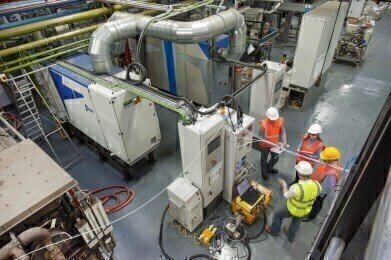Air Monitoring
FTIR Gas Analyser Supports Carbon Capture Research
Mar 31 2015
A Gasmet FTIR multiparameter gas analyser is being employed at the UK Carbon Capture & Storage Research Centre, providing accurate measurement of CO2 in addition to a wide array of other gases. This Pilot-scale Advanced Capture Technology (PACT) facility was created to catalyse and support industrial and academic research to accelerate the development and commercialisation of novel technologies, to bridge the gap between bench-scale R&D and industrial pilot trials, and to provide shared access to industry and academia.
Background
The combustion of carbon-based fuels creates CO2 which is an important greenhouse gas and contributes to global warming. Growing atmospheric levels of CO2 also have other effects such as ocean acidification and there are a number of global initiatives to reduce CO2 emissions. For example, the UK has a legally binding target to lower greenhouse gas emissions by at least 80% (from the 1990 baseline) by 2050. This can be achieved by switching to renewable sources such as biomass, solar, wind and tidal energy, by utilising energy more efficiently and by the development of low-carbon technologies such as CCS.
CCS is able to remove up to 90% of the CO2 emissions from combustion and power generation plants by first capturing carbon; second transportation and thirdly deposition in a selected geological rock formation that is typically located several kilometres below the earth's surface - in depleted oil and gas fields or deep saline aquifers for example.
There are three possible methods for carbon capture: pre-combustion capture, post-combustion capture and oxyfuel combustion. However, these technologies need to be developed and trialled on a pilot-scale before they can be implemented on new or existing facilities.
PACT and FTIR gas analysis
The UKCCSRC PACT facilities are funded jointly by the Engineering and Physical Sciences Research Council and the Department of Energy and Climate Change with six University partners: Cranfield, Edinburgh, Imperial, Leeds, Nottingham and Sheffield. They provide specialist national facilities for research in advanced fossil-fuel energy, bioenergy and carbon capture technologies, including a comprehensive range of pilot-scale facilities, specialist research and analytical facilities, all supported by leading academic expertise.
The Beighton site near Sheffield provides researchers and industry with pilot-scale facilities for all three of the carbon capture methods and PACT Business Development Manager Dr Kris Milkowski, from the University of Leeds, says: “FTIR gas analysis performs a vital role in our work with all of these methods; enabling us to monitor CO2 levels in addition to almost any other gas from the Gasmet library of over 5,000 compounds. For example, in addition to CO2 monitoring of the CCS plant exhaust, it is also necessary to check for solvents and any degradation products that may be present.
“Previously, we utilised racks of single-parameter analysers but this limited our work to a small number of gases, whereas the possibilities with FTIR are almost endless. Not only do we have the ability to identify unknown peaks in the data, but we also have the facility to analyse recorded spectra retrospectively, which means that, in the future, we will be able to measure compounds that we were not necessarily of interest at the time the analysis took place.
“The flexibility of the DX4000 system is extremely important for our work because each programme of research studies different aspects of combustion control and carbon capture, so the ability to specify measurement parameters for each programme is a major advantage.
“The portability of the analyser is also a great benefit because it can be quickly relocated when necessary, including deployment at industrial sites and with a transportable CCS system that is based in Edinburgh. This unit is capable of processing 25-50m3 of flue gas per day and runs a number of small?scale test units operated in parallel to reproduce capture processes conditions.”
The Gasmet DX4000 FTIR analyser was supplied and configured by Gasmet’s UK Distributor Quantitech. “The system was delivered with a sampling system and heated sample lines so that hot, wet and even corrosive gases can be measured,” says Quantitech Sales Director Dominic Duggan. “Similar systems have already been supplied to full-scale CCS systems, so we were delighted to be involved with the PACT facility which we believe will make a major contribution to the development of CCS in the UK and beyond.”
Highlighting a further benefit of PACT’s relationship with Quantitech, Dr Milkowski says: “The availability of rentable Gasmet FTIR systems from Quantitech is important because most of our projects incur a substantial investment in resources within a tightly defined time-scale, so, even though we have not yet had cause to make use of a backup system, it is comforting to know that FTIR systems could be made available at short notice if necessary.”
CCS technology – Solvent Absorption
The UKCCSRC PACT site at Beighton includes a Solvent-based Carbon Capture Plant (SCCP) which enables the development, evaluation and optimisation of a variety of solvents for post-combustion capture. It is designed to remove up to 1 tonne/day of CO2 from an equivalent of approximately 150kW conventional coal combustion flue gas. The plant incorporates an 8m absorber column equipped with temperature and differential pressure sensors, solvent sampling ports, provisions for corrosion coupons and alternative materials test sites, and trace gas injection capability. The plant also has an integrated flue gas desulphurisation carbonate wash system.
Typical flue gas CO2 levels following coal combustion are around 12% and, depending on the solvent and the flow rate, the concentration following carbon capture is about 1%.
The SCCP is connected directly to the PACT combustion facilities which include a 250kW Air Combustion Plant and the 300kW Gas Turbine System, enabling post-combustion capture research from real flue gases from natural gas power plants as well as pulverised fuel combustion plants including coal, biomass and co-firing. The facility is also connected to a dedicated gas mixing facility enabling carbon capture from any synthesised flue gas compositions, including industrial effluent gas mixtures.
Summarising, the advantages of PACT’s gas monitoring system, Dominic Duggan says: “Dr Milkowski’s work with the Gasmet DX4000 analyser has clearly demonstrated the suitability of multiparameter FTIR for monitoring CCS plants. In most applications we would recommend a fixed continuous emissions monitoring system (CEMS) for such applications, however, as a research site, the PACT facility requires maximum flexibility in its resources, so the portability of this system is ideal for PACT’s work.”
Digital Edition
IET 34.2 March 2024
April 2024
Gas Detection - Biogas batch fermentation system for laboratory use with automatic gas analysis in real time Water/Wastewater - Upcycling sensors for sustainable nature management - Prist...
View all digital editions
Events
Apr 22 2024 Hannover, Germany
Apr 22 2024 Marrakech, Morroco
Apr 23 2024 Kuala Lumpur, Malaysia
Apr 23 2024 Kintex, South Korea
Apr 23 2024 Edmonton, AB, Canada



















